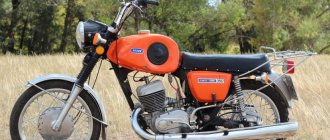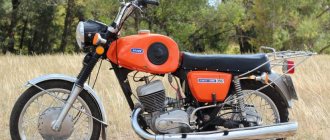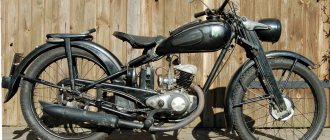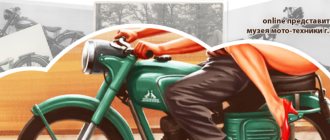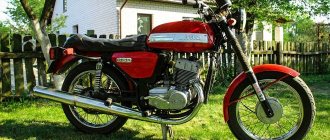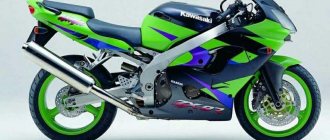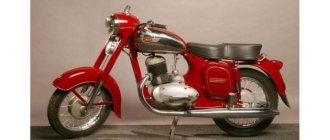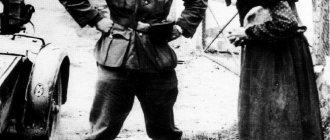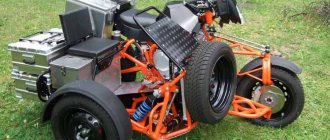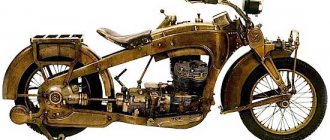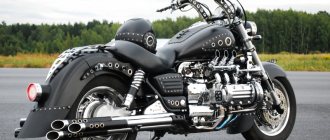Story
The first Java model, produced under license from Wanderer from 1929, had a four-stroke engine with a cylinder capacity of 500 cm3, was quite complex, expensive and was not in demand. Success for the brand came with the development in 1931 of a light motorcycle with a two-stroke engine with a cylinder capacity of 175 cm3. In 1934, a four-stroke Java with an engine capacity of 350 cm3 was mastered, then a two-stroke with an engine capacity of 250 cm3. In 1937, production of the Java-Robot motorbike began.
After the occupation of Czechoslovakia in 1938, the plant came under the control of the German authorities and began producing military equipment. However, the development of new motorcycle models on it continued. By the end of 1944, the company had prepared for production new models of motorcycles with two-stroke engines of 250 and 350 cm3 and a spark plug rear suspension designed by DKW.
After the liberation of Czechoslovakia, the plant was nationalized and resumed motorcycle production in May 1945. In 1946, the new Java 250 model created a sensation at an exhibition in Paris, winning a gold medal. For its smooth ride, the motorcycle received the nickname “Perak” (springy).
In 1953, production of a new family of Java motorcycles with two-stroke engines of 250 and 350 cm3 and a pendulum rear suspension was launched. The motorcycles were produced jointly with another Czech company CZ.
In 1970, production began of a new series of Java 250-623 and 350-633 motorcycles, distinguished by their original design. The motorcycles had a backbone frame and an engine with a separate lubrication system. In 1973, the Java 350-634 model with a duplex closed frame and a new engine went into production. The production of motorcycles with an engine capacity of 250 cm3 ceased. After modernization in 1984, the model received the index 638 and continues to be produced with minor changes. The total number of Java motorcycles produced in the 80s exceeded 3 million units.
The Java-India joint venture under the Ezdi brand has produced the Java-250 model since 1960, and the Java-350 model since 1983.
After the collapse of the CMEA, the production of Java motorcycles decreased sharply, but the company managed to stay afloat and maintain the production of motorcycles of the original design. The range of models has expanded to include motorcycles with more powerful Rotax and Honda engines.
Models[ | ]
Old models[ | ]
"Java 500 OHV" "Java 353" (1956) "Java 350", type 634 "Java 350", type 639 "Twin Sport" (1988) "Java 350", type 640 Modern models of Java motorcycles at the exhibition "Motopark 2011"
- Jawa 500 OHV Rumpal (1929);
- Jawa 175 Villiers (1932);
- Jawa 350 SV (1934);
- Jawa 350 OHV SPECIÁL (1935);
- Jawa 250 (Zweitakter) (1935);
- Jawa-Robot 100 (1937);
- Jawa 250 Duplex Blok (1939);
- Jawa 250 Perák typ 10, 11 (1946);
- Jawa 350 (Ogar) typ 12 (1948);
- Jawa 500 OHC typ 15 (1952);
- Jawa 250 Sport (1954);
- Jawa-CZ 150 typ 352 (mezityp) (1954);
- Jawa 250 typ 353 (1954);
- Jawa 350 typ 354 (1954);
- Jawa 50 Pionýr (1955);
- Jawa-CZ 125 typ 351 (mezityp) (1956);
- Jawa 175 typ 356 (1956);
- Jawa 250 typ 559 (1957);
- Jawa 50 typ 05/Jawa 05;
- Jawa 50 typ 220.100;
- Jawa 50 typ 223.200;
- Jawa 50 typ 550;
- Jawa 50 typ 551 Jawetta Standard (1959);
- Jawa 50 typ 555 Pionýr (1958);
- Jawa 50 typ 20;
- Jawa 50 typ 21;
- Jawa 250 Kývačka typ 559/03 Automatic (1963);
- Jawa 350 Kývačka Automatic typ 360/01 (1965);
- Jawa 350 Road King typ 361 (1965);
- Jawa 250 typ 590 (1965);
- Jawa 250 typ 559/05 Automatic (1966—1968);
- Jawa 350 California IV typ 362, 363 (1969);
- Jawa 23 (genannt JAWA Mustang, 50 cm³);
- Java 25;
- Jawa 350 UŘ typ 633/1 Bizon (1970);
- Jawa 350 typ 634, 634.5 (1973-1982);
- Jawa 350 typ 638 (1984-1991);
- Jawa 350 typ 639 (1990);
- Jawa 125 Dandy (1998);
- Jawa 50 Dandy typ Minarelli (1999);
- Jawa 125 Dakar (2003);
- Jawa 650 typ 836 (2004);
- Jawa 650 Classic (2004);
- Jawa 650 Style (2005);
- Jawa 650 Dakar (2006);
- Jawa 250 Travel (2007);
- Jawa 660 Sportard/Vintage (2011);
Motorcycles currently on sale[ | ]
- Jawa 350 typ 640 (Style/Retro, 1991);
- Jawa 350 OHC (2017);
- Jawa 300 CL (2018) (licensed production in India)
- Jawa RVM 500 - (2020) (licensed production in Argentina)
Motorcycle in the USSR
The USSR was the main importer of Java. In total, more than a million motorcycles of various models were delivered to the Soviet Union.
The constant problem with purchasing spare parts was solved to some extent with the help of orders through Posyltorg.
The last Java model supplied to the USSR in the late 1980s and early 1990s was the Java 350-638. The first Java 638 appeared in 1984 and bore the index 5. It was similar to the model 634-7. The differences were a new engine, 12-volt electrics, and a new front fork. The front wing was painted red, and the rear wing was painted black. The 634th model had wings painted light gray. Also on the instrument cluster, the neutral light is green. The tachometer received a green scale (Economic).
In 1986, Java 350-638-00 appeared, for the characteristic shape of the rear part it was also called “Pencil”. It was also called “Banana” or “Squirrel” because of the rear spoiler. In 1989, Java 350-638 appeared with the index 1-03, which received the popular name “Lux”, “Super” and “Stub”. It was distinguished by longer exhaust pipes and, accordingly, a larger bending radius, which led to the effect of raised mufflers. The mufflers themselves became shorter in length (like the model 634) and received dents on the inside in the area where the shock absorbers were installed, and the upper mount of the rear shock absorbers on the frame changed. Also, stickers took the place of the metal nameplates located on the gas tank and side covers. In the same year, model 638-1-04 (Twin Sport) appeared, with different decals and Cezet shock absorbers.
Notes[ | ]
- Autoreview Museum - JAVA Motorcycles (undefined)
(inaccessible link). Retrieved July 9, 2009. Archived July 7, 2009. - ↑ 1 2 3 4 5 6
Encyclopedia of motorcycles (Companies, Models, Designs) /
A. E. Vorontsov, E. V. Pevzner, D. V. Dolnikov, A. G. Popov, R. M. Sazonov
. — M: Publishing House “Behind the Wheel”, 2003. - In the world of motors (undefined)
. Behind the Wheel, No. 2, 1984 (February 1984). Date accessed: January 7, 2020. - Jan Buzek.
Seminar in Chertanovo
(unspecified)
. Behind the Wheel, No. 10, 1984 (October 1984). Date accessed: January 7, 2020. - three new motorcycles equipped with an anti-lock braking system ABS were presented
- As in India, in Europe JAWA will be represented by three models
- Our partner "Motokov" (undefined)
. Behind the Wheel, No. 11, 1983 (November 1983). Date accessed: January 7, 2020. - E. Kovrizhenko.
Meeting of friends
(undefined)
. Behind the Wheel, No. 9, 1985 (September 1985). Date accessed: January 7, 2020. - B. Sinelnikov.
Unpromising direction
(undefined)
. Behind the Wheel, No. 8, 1987 (August 1987). Date accessed: January 7, 2020. - History of Java mopeds
Motorsports
Java motorcycles have successfully performed in sports, in particular in motocross and six-day Enduro competitions. Particularly significant successes were achieved in speedway and ice speedway. In the 60-70s of the 20th century, Java motorcycles with four-stroke engines were among the best speedway motorcycles in the world. They were attended by multiple speedway world champions Barry Briggs, Ivan Mauger, Ole Olsen and many other athletes. On Java motorcycles, Soviet and Russian racers Gabdrakhman Kadyrov, Sergei Tarabanko, Anatoly Bondarenko, Nikolai Krasnikov and others repeatedly became world champions in ice speedway. The Russian national ice speedway team continues to use Java motorcycles.
Decent characteristics of Java 350
The bike, unlike its predecessors, received a two-stroke two-cylinder engine with a volume of 350 cc.
cm, air-cooled. Power increased to 16 hp. s., and in later versions, after installing a new carburetor, up to 18 liters. With. By the way, the Java 350 carburetor was subsequently modified several times. The maximum speed was 115 km/h (with a direct landing of the motorcyclist). The drum brakes worked reliably, and the front and rear forks with telescopic shock absorbers ensured comfortable movement on paved roads.
This became especially noticeable in 1958, when cone-type shock absorbers were replaced with piston ones. The voltage of the battery and generator used to operate the electrical equipment of the Java 350 motorcycle is 6 volts. Weight – 139 kg. Consumption, for that time, was very moderate - 3.6 liters.
The appearance of the model not only corresponded to the trends of the time, but was progressive and well thought out. It was the modification 354/06 that Viktor Tsoi was seated on by the author of the monument to the famous rock musician, Alexey Blagovestnov. As an element of a monumental composition, old Java looks very harmonious.
Refinement and tuning
Since the new Java 638 is very popular and the demand for this motorcycle does not subside, craftsmen continue to refine both the appearance of the motorcycle and its characteristics. On the Internet you can find many reviews and interesting technical solutions for tuning this motorcycle.
The change in appearance is sometimes so dramatic that it is difficult to believe that this motorcycle was once a classic java. The wheel rims are replaced with cast light alloy ones, the old front steering wheel fork is replaced with a more advanced, longer one, the seats and headlight are changed. There are simply no limits to the imagination of inventors.
To improve driving characteristics, drum brakes are replaced with higher quality disc brakes. To increase the service life of the engine, the bearing seats are changed, thereby improving their lubrication.
Previous entry Java 350 - parameters and special properties of the legend Next entry Technical characteristics of the Planet Izh 4 motorcycle
FAQ
- Do the spare parts for 634 and 638 fit together? For the most part, yes. But parts for a more recent model, that is, 638, are more often found on sale.
- How many horses are there in Java 350? Exactly 26 fast horses. True, no one remembers exactly how the Czechoslovak plant measured power, at the crankshaft or at the rear wheel.
- I have an old anniversary car in my garage, I got it from my grandfather, it hasn’t started for about twenty years, but it looks decent. Does it make sense to invest in restoration for the purpose of selling? Yes, if the bike is in overall good condition. Collectible pieces can be quite expensive.
- What is the lifespan of this motor? There is no exact data, but there are reviews from owners who claim that the engine runs 30,000 km or more without repairs.
- How much does the Java 350 motorcycle weigh? Curb weight with all fluids and other things is about 185 kg, dry weight is about 156 kg.
Specifications
It was not for nothing that Soviet motorcyclists dreamed of this model! The Java 350's technical characteristics are quite good, especially for its time, although now they look hopelessly behind. But this motorcycle was first released almost 40 years ago, and it would be unfair to demand that it meet modern standards.
Engine
The simplest (but for its time - very progressive!) 2-stroke 2-cylinder engine requires gasoline with added oil to be poured into the gas tank so that the mechanisms can be properly lubricated. Power is 26 hp, and this engine is capable of accelerating the motorcycle to a maximum speed of 130 km/h. The two-stroke power unit does not have a long service life, but it is still quite durable.
Transmission
The gearbox does not have 5 gears, as bikers are used to these days, but only 4. But the gear ratios are quite long, so they are enough. And in everything related to reliability, the Java 350 gearbox can serve as a role model for many Chinese defectors, who in the 21st century manage to rivet motorcycles with gearboxes that jam at every tenth shift.
Chassis and brakes
The steel frame with the entire structure described above rests on four standard shock absorbers - two at the rear plus a fork at the front. There are no settings provided, which was the norm for the 80s of the last century. The brakes are also simple, drum, and there is no disc brake even on the front wheel. The braking distance is quite significant, since the bike weighs a lot.
Electronics
For this model, for the first time, a 12-volt battery was used instead of 6. This benefited the motorcycle - its electrical circuit is extremely simple, albeit archaic. Charging of the battery begins when the engine picks up speed from 1000 per minute and above, and is provided by a generator working in conjunction with a diode voltage rectifier. Compared to the previous model of the Czechoslovak plant, the generator has become as much as 2.8 times more powerful.
Weight and dimensions
The dry weight of the bike is quite large, 156 kg without a sidecar. In that era, no one particularly thought about the use of more modern technologies in order to reduce weight and, accordingly, improve power availability. However, compared to many Soviet motorcycles, the brainchild of Czechoslovak engineers does not seem heavy at all.
Controllability
These days, this bike would probably be called a “dual-purpose motorcycle.” It copes equally well with driving both on asphalt and on dirt roads, and even light off-roading is up to it, especially if you take care of purchasing suitable tires. If you compare it not with modern motorcycles, but with those that were produced at the end of the USSR, it will be very good.
Fuel consumption
The Java 350 is capable of running on any gasoline you can find. Don't forget to mix it with oil in a ratio of 40 to 1! And if you change the engine or some elements of the piston group, then the ratio should be 33 to 1, according to the manufacturer’s recommendation. Fuel consumption on the highway can reach 5 liters per 100 km, and in urban conditions it can rise to 7 liters.
Advantages and disadvantages
The Java 350 needs to be compared with contemporary motorcycles, and not with models produced today. And for its era, this bike was, without exaggeration, magnificent! It was not for nothing that it was so popular in the USSR, despite the fact that Soviet motorcyclists had to order spare parts for it from the allied Czechoslovakia using various tricks.
Advantages
- Power. All sorts of “Voskhods” and “Izhi” could not compete with the Czechoslovak motorcycle on the road.
- Significant service life of the engine and CPG, noticeably longer than most Soviet bikes.
- Moderate mass, less than that of the Ural or Jupiter.
Flaws
- Difficulty finding spare parts these days. You can find everything, but you have to run.
- Compared to modern competitors, Java 634’s technical characteristics cannot stand any comparison even with the “Chinese”. The 638 model, however, does the same.
- It’s simply a pity to use the completed Java 350 as a vehicle for every day.
Next step
But time took its toll, and the management of the Czech company decided to make serious changes. In 1973, motorcycle enthusiasts had the opportunity to get acquainted with the Java-350 type 634. On the new bike, the frame design was changed and the engine design was seriously redesigned, increasing power to 23 hp. With.
The maximum speed indicated in the technical description, despite the weight gain of up to 160 kg, increased to 125 km/h. True, fuel consumption has also increased, amounting to 4.5 liters of gasoline per hundred kilometers at a speed of 80 km/h. The advantages of the model are:
- Ease of control and stability at high speeds, which, combined with a comfortable suspension and comfortable seating, had a beneficial effect on the fatigue of the motorcyclist. It was possible to cover a considerable distance behind the wheel without any problems.
- Operational reliability and solid design life.
The main disadvantage was considered to be the high price.
Copy or original?
However, both Jawa 350 Premier and Jawa 350 Replica are unlikely to satisfy a true connoisseur of the legendary brand’s products. Why do they need copies when they can buy the original? After all, in our country you can still find and restore classic Java motorcycles to their original condition. And tuning is inappropriate here!
If you still want to remake some motorcycle equipment to your liking, then on our website you can find out about tuning the Voskhod-3M, a Soviet motorcycle that was mass-produced at the Degtyarev plant in the city of Kovrov.
Previous entry Composition and parameters of electrical equipment IZH Jupiter 5 Next entry Motorcycle Java 350 638: review, technical characteristics
Repair and tuning
All Soviet-era equipment, even imported, is distinguished by its simplicity of design. This is both good and bad. Maintainability in this case goes hand in hand with outdated technologies, which these days are not used even by Chinese and Indian motorcycle manufacturers specializing in extremely low-cost equipment.
Repair
Who will drag Java 350 to the service? Such motorcycles are repaired in the garage, with love and strong words when something doesn’t work out. But seriously, even an inexperienced motorcyclist can understand the design of a Czechoslovakian bike, because it is extremely simple. The wear resistance of some components is low, but they are very easy to repair or replace.
Spare parts
It is very difficult to find original spare parts for a model that was discontinued a long time ago, and you only need to look for it on message boards, owner forums, and so on. They are almost never sold in stores, although there are Chinese analogues of unknown quality. However, they are still not suitable for restoring a motorcycle to its original condition.
Tuning
In the past, this bike was often tuned, especially in rural areas, but now it seems blasphemous. Such motorcycle equipment, which has survived to this day, needs to be carefully restored, and not turned into a traveling exhibit of the “Collective Farm Tuning of the Year” exhibition. And those who do not agree with this, and intend to turn an old Java into a “chopper type” or “sportbike type” with the help of an angle grinder and a sledgehammer, need to be beaten for a long time and thoughtfully with an adjustable wrench until they realize the fallacy of their intentions.
Technical and operational characteristics of jawa 350 638
Jawa 350 638 has the following technical characteristics:
- Overall dimensions - 2110x750x1070 mm.
- Seat height - 810 mm.
- Ground clearance is 130 mm.
- Wheelbase - 1335 mm.
- Weight without fuel - 156 kg.
- Engine type: 2-cylinder, 2-stroke.
- Engine capacity - 350 cubic meters. mm.
- Power - 26 hp
- Tank volume - 17 l.
- Maximum speed is 130 km/h.
The fuel consumption of the Java 350 638 motorcycle is about 6-7 liters per hundred, which is a pretty good indicator for this class of motorcycle of that time, because only Japanese motorcycles, which are much more expensive, gave similar results.
Smooth running was achieved by a 4-speed gearbox consisting of three main shafts. The steering function was a conventional Java 638 telescopic fork. The electrical circuit of the motorcycle is based on a 12V circuit. Generator Java 638 with a power of 210 W, at 14V and 15A at 5000 rpm.
The Java 638 carburetor is a float carburetor with a central chamber equipped with a device for easy engine starting
When operating a motorcycle, it is necessary to pay due attention to the Java 638 crankshaft, because due to insufficient lubrication, this is a rather vulnerable part of the motorcycle
Technical component
Now about the technical part. This motorcycle had a classic design. The frame was a tubular carrier, and all the elements were attached to it.
The front suspension consisted of a front telescopic hydraulic fork.
At the rear there is a pendulum with two shock absorbers. The braking system is completely drum, with a cable drive at the front and a traction system at the rear.
The power plant is a two-cylinder, two-stroke, in-line arrangement. Cooling is air, and the power system is carburetor. The power plant was started by foot.
The gearbox was foot-switched and had 4 speeds. The drive to the rear wheel was carried out via a chain drive.
The motorcycle was simple in design, but precisely because of this, and even with its spectacular appearance, it was a desirable vehicle for many.
New standards
In 1984, a new modification, type 638, went into production. Changes affected the power unit. The profile and flow area of the intake and exhaust channels were changed, improving the purging of the cylinders. The Java 350 engine received an aluminum cylinder block and lightweight pistons. Power increased to 27 hp. s., and fuel consumption decreased to 4.2 liters. The maximum speed remained unchanged.
An important innovation was the installation of electrical equipment operating at a voltage of 12 volts. The new 12-volt system has significantly reduced the weight of the generator and other electrical components. The measures taken led to a weight reduction to 149 kg. It is based on this model that the Jawa 350 Replica is being produced today.
During production, the design on these Javascripts was adjusted several times. The shape and finish of the fuel tank changed. A small fairing was installed on the steering wheel. No matter what changes the Java 350 underwent, the technical characteristics were at a high level.
Model appearance
Outwardly, although it was relatively simple, it still attracted attention. The large headlight, with round turn signals protruding on the sides, and the dashboard wells located on top, combined very harmoniously... And even though the wheels on the motorcycle were spoked, they sparkled very well in the sun.
And even though the wheels on the motorcycle were spoked, they sparkled very well in the sun.
The tank of the motorcycle was voluminous, but it had a neat shape; in the rear there were quite large pads for the driver’s knees. But the most important thing on the tank was the inscription “Jawa”.
The 638 had a double, flat seat divided in the middle by a strap for the passenger to hold onto. There were glove compartments under the seat and tank on both sides.
This motorcycle received the nickname “Bench” due to the fact that under the seat there were decorative pads that stretched along the entire seat and ended with a brake light. Because of this, the seat was combined with the rear brake light.
The two-cylinder engine was completely open to view, all its components were clearly visible, although its openness played an important role - the engine was air-cooled.
The advantages of this motorcycle included a very stylish appearance, which Soviet motorcycles, for example, IZH products, were very far from achieving.
In addition to this, the engine had a higher revving speed, which made this bike unrivaled. Many also really liked the decision to launch a motorcycle.
Its gear shift foot also served as a kick starter; it was enough to press the foot a little into the gearbox housing and lift it up.
Of all the shortcomings of this motorcycle, only the shortage of spare parts can be highlighted. Like any other motorcycle, it could break down and parts were hard to come by.
